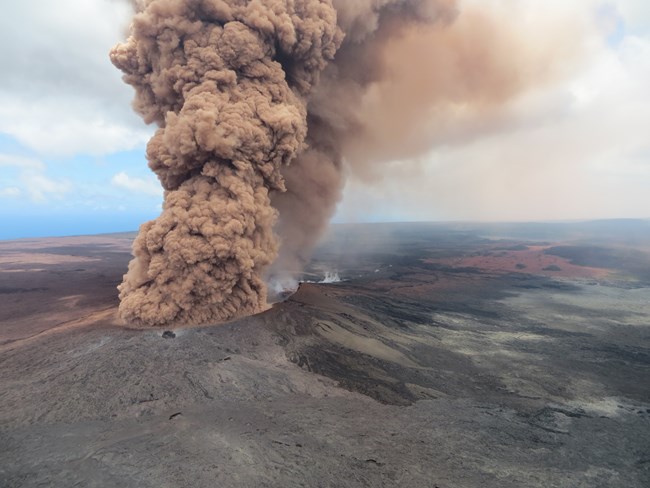|
Visit our keyboard shortcuts docs for details
In 2018, a new eruption of Kīlauea volcano changed the island of Hawai‘i forever. From May through August, large lava flows covered land southeast of the park destroying over 700 homes and devastating residential areas in the Puna District. At the same time, the summit area of the park was dramatically changed by tens of thousands of earthquakes, towering ash plumes, and a massive collapse of Kīlauea caldera. 
Prelude to HulihiaHulihia: "overturned; a complete change, overthrow; turned upside down." In March 2018, Kīlauea was erupting in two different places, an uncommon phenomenon that had been happening for nearly a decade: at the summit in Halemaʻumaʻu crater, and down the East Rift Zone at Puʻuʻōʻō. These two long-lasting eruptions changed drastically in the middle of March, when USGS scientists discovered a signficant increase in pressure in the magma system below Puʻuʻōʻō. With the pressure increasing at Puʻuʻōʻō, the summit of Kīlauea also started to show similar signs of inflation. The lava lake in Halemaʻumaʻu soon began to rise. By April, pressure increased so much that the lava lake overflowed onto the crater floor, drawing over 10,000 park visitors per day. Two Eruptions End, Another BeginsOn April 30th, the summit of Puʻuʻōʻō collapsed, an event that USGS scientists have since determined marked the end of the 35-year eruption which first began in 1983. 48 hours after the Puʻuʻōʻō collapse, the lava lake at the Kīlauea summit started to drop significantly. Magma started to drain away from the summit of the volcano, moving underground to the middle and Lower East Rift Zone, marked by a series of earthquakes.
On May 3rd 2018, the first fissure of the eruption opened up in a residential subdivision, Leilani Estates. The following day, on May 4th, the island was struck by a magnitude 6.9 earthquake as magma continued its move to the Lower East Rift Zone. Over the next two months, lava covered 13.7 square miles of land, several dozens of feet deep in places. The flows in the Lower East Rift Zone destroyed 700 homes, displaced over 2,000 people, covered 30 miles of road, and added an astounding 875 acres of new land to the island.
Summit CollapseAs the summit adjusted to the withdrawal of magma further down in the rift zone, it caused powerful earthquakes and collapse events up top. Every 28 hours on average, the ground within the summit caldera of Kīlauea sank. These collapses were followed by large air-borne plumes of ash. This dramatic cycle continued through July 2018, dramatically re-shaping the summit landscape of Kīlauea. From May through August, over 60,000 earthquakes shook the area. 
Kīlauea Summit - Before & After Collapse 

Left image
Right image
Kīlauea Summit - Before & After Collapse 

Left image
Right image
USGS Publication Preliminary summary of Kīlauea Volcano’s 2018 lower East Rift Zone eruption and summit collapse (pdf 10.2MB) |
Last updated: June 7, 2021

